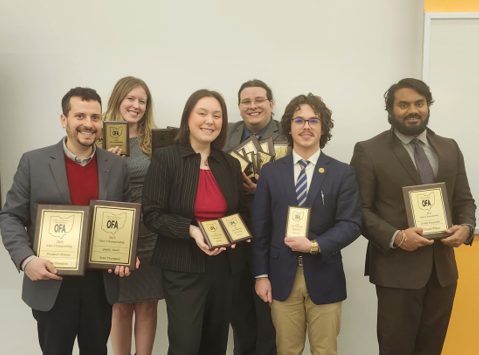A Conversation with U Akron Park: What campus parking has to say about student’s frustrations
Most University of Akron students have faced the universal horror of not being able to find a parking space throughout the university parking destinations. The familiar feeling of seeing rows upon rows of cars beat you to the punch is a common frustration among students. Students also question the lack of space, the steep cost of parking permits, and the unclear policies. Naturally, these frustrations cause students to question how parking operates and why they can’t fix these recurring concerns.
I [Hill] sat down with the Executive Director of UAkronPark, Jared Coleman, and Communications Manager, Lauren Divoky, from UAkronPark to review some of the most pressing questions from the student body.
In 2023, UAkronPark entered a 35-year deal with the University of Akron where they operate and maintain the parking system. UAkronPark is a non-profit and is only interested in reinvesting in the future of the university.
Q: What does UAkronPark do as a part of this contract?
A: “We are responsible for the capital maintenance and repair of the facility. So, paving when it comes to surface lots and to parking garages. We’re also responsible for operational maintenance so the cleanliness of facilities. Were the ones that go around and empty the trash cans. We’re responsible for issuing parking permits and enforcement. Were the ones who patrol the lots and make sure that everyone’s following the rules.”
Q: What is the ultimate goal of UAkronPark?
A: “Our ultimate goal is to monetize the parking system on behalf of the university in such a way that we generate surplus revenue that the university needs. In order to help them with their revitalization, we want to do this in a such way that protects and enhances the name and reputation of the university. We want visitors to see the value of what we’re doing on campus.”
Q: Why did the University decide to take the deal [between UAkronPark]?
A: “This deal was advantageous to the university because they were able to take a lot responsibilities off their balance sheet. There was an existing debt for the parking system because when these parking garages were built the university didn’t front the millions of dollars for each garage. They went out and issued bonds to borrow the money. With this deal, they were given a 55-million-dollar upfront payment which they were able to defense that debt. The parking system previously had a lot of deferred maintenance. These were maintenance needs that would ideally be handled each year but with the state of the budget, it was in rough shape. They needed to be able to address those things, they had been operating the system at a loss for many years. For many years the parking system has not been self-sufficient and losing money each year.”

Q: Are you aware that students are dissatisfied with parking?
A: “We do hear from students in a number of ways. We have a really good relationship with Undergraduate Student Government and Graduate Student Government, Lauren takes the lead on that relationship. They have been really helpful in letting us hear from students. We are actually required in the contract every two years to conduct a customer satisfaction survey. We talk to students when they come into our office for assistance with buying parking permits or if they want to talk about tickets that they receive. When tickets get appealed we hear rationales for why they think their appeal should be granted. They take that opportunity to complain if they feel like a rule is not fair.”
Q: After hearing student feedback are there any changes you can make?
A: “Sometimes there is and sometimes there isn’t. We always want to hear it[student feedback]but some things are not going to change. Or at least not going to change just due to a complaint. Nobody likes it when the price of parking is increased, that was all determined when the deal was signed. We had to build a model for 35 years of this to project revenues and expenses, to show our ratings agency that this was a realistic business plan to get our ratings so we can go out and borrow those funds. We can’t simply snap our fingers and go against that now. We are trying to be the best partners we can with the University. We don’t give the administration automatic no’s about anything unless it’s very clear cut. The University Council had asked, “couldn’t we have some more leniency as far as one warning ticket for the first one.” We talked over it internally and decided it makes sense. So we changed our policy to make it if you had not been ticketed on campus before and you get ticketed for a license plate not facing the drive aisle it’s going to be a warning the first time. That’s an example of how we have tried to work based on student feedback.”
LD: “Another example of us listening to feedback that we were able to act on is the commuter overnight permit. Last semester the day permit was originally set until 10 p.m. We got a lot of complaints of students staying late at the library who had to buy an overnight permit if they were going to park from 10:01 to 6 a.m. We moved that time back to midnight, so you didn’t have to purchase an overnight permit. We can do things especially when they’re reasonable requests, like extending the timeframe of a regular commuter permit.”
Q: Why are there limited parking spaces available to students?
A: “It’s interesting for me to hear this because the situation on this campus is so much better than it is at most universities in terms of parking. If you look at the overall number of students, faculty, and staff that are here every day, and look at the number of parking spaces we have. We have an abundance; we have way more than we need. At the East Campus Parking Deck, you can drive into circle up and you’ll see almost the whole thing is empty. We do not have a shortage of parking spaces on this campus. What we do have is a perceived shortage of parking spaces in a limited area of campus. I say perceived because there are places where you only look at one lot and yeah that lot is going to stay full throughout the day. The best lot to give as an example is lot 34. You could be driving around for a while if you’re trying to get in at peak times if you’re not willing even to consider parking slightly further away. Meaning one or two blocks away. But we give students good alternatives a short walking distance away. It’s just not a realistic perspective to think that you can park on a university campus in a lot immediately adjacent to your building.”
Q: “Why charge students nearly $500 a year for parking when they’re already struggling between tuition, bills, and other responsibilities?” What is your reaction to this quote?
A: “The prices that we’re charging for parking represent the true cost of providing that parking. We must approach it from that angle, but that doesn’t mean that we’re not sensitive to students. The right way to do it is to make sure you’re looking at what’s the true cost of operating and maintaining the parking system, the number of users in that system, and setting the pricing appropriately so you’re covering the cost of that system. One thing that we do to help students is we have a payment plan option for the permit. We understand that a student might have a hard time coming up with the full price of the permit upfront.”
Q: Why isn’t the cost of parking included in the tuition?
A: “Most universities don’t [include parking with tuition] for good reason. Parking is not an automatic thing. Not everybody parks. For example, there are a lot of high school students on this campus, through College Credit Plus and early high school. There are a decent number of them who get dropped off that don’t park here. There are other students that live close to campus and there are students who live in our resident halls who make their home here on campus, and who don’t have a vehicle. In that sense, it’s more equitable to not just automatically charge them for parking but to make it an optional fee that they choose to pay if they need the privilege of parking. So that way only the people who need it are paying for it.
Parking on campus at the University of Akron (UA) remains a hot topic of frustration among students, with concerns about limited availability, steep pricing, and unclear policies dominating the conversation. For many commuters, the daily battle to secure a spot is not just an inconvenience but a disruption to their academic schedules.
Samone White, a UA student, shared her candid thoughts on the issue, describing the parking situation as “a pain in the behind.” She pointed to a lack of parking spaces and high costs as major factors contributing to her frustration. According to White, the closure of parking decks on campus has worsened the problem, forcing commuters to look for alternative spots. “Finding somewhere to park that’s out of the way causes unnecessary tardiness to class,” she explained.
The availability of parking spaces presents a significant challenge for students, particularly during the busiest hours of the day. According to White, mornings are especially difficult for commuters, as the demand for parking often exceeds availability. “Parking is especially difficult in the mornings around 8 to 11 o’clock,” she shared. “If you want to get a parking spot anywhere, you have to come before that time, but even that’s not guaranteed because everyone has the same idea.” This struggle highlights the ongoing frustration with limited parking options during peak times.
Another source of dissatisfaction is the cost of parking permits. UA charges $236 per semester or $473 for a full year. For White, this is an unreasonable expense. “It’s almost $500 for a year, and I’m only on campus three days a week for a single one-hour class,” she said, emphasizing how the high cost feels disproportionate to her usage. To gain some perspective, Stark State has a campus in Akron and a campus in Canton. To obtain a parking pass, it is free when you visit the student center for the first time. Although it is a smaller campus with less students, it shows the possibility of parking in big cities for universities. Another alternative is to use public parking such as the lot across from the Akron City Hall (The Summit County Parking Deck). The parking deck charges $1.25 an hour and maxes out at $6.00. If you visit campus only two times a week for a 15-week semester and you are maxing out the charge of $6.00, this would mean you would pay $180 for the semester, which is $56.00 cheaper than obtaining a UA Parking Pass.
White also believes the university’s parking policies could be clearer and more equitable. “In some areas, there’s definitely room for improvement,” she remarked. She suggested a simplified and more affordable pricing structure, advocating for an annual flat rate instead of separate semester fees.
Additionally, White raised broader concerns about the financial burden placed on students. “It’s crazy that something as simple as parking costs more than my car note,” she said. For many students juggling part-time jobs, tuition, and other living expenses, the added cost of parking feels unnecessary. She questioned why parking fees aren’t included in tuition, noting that students already pay substantial amounts to attend classes on campus.
The frustration isn’t just about money or convenience; it’s about fairness. White argued that the university has sufficient resources to address these issues.
Whether through clearer policies, more accessible pricing, or investments in additional parking spaces, addressing these frustrations could improve the daily experience for students and faculty alike. As the conversation around campus parking continues, students like White hope the university will take steps to create a more accommodating and affordable system, ensuring that parking is one less thing for students to worry about during their academic journeys.













